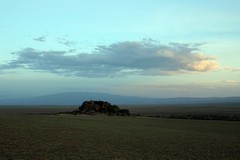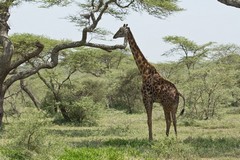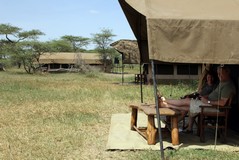The Serengeti National Park in Northern Tanzania is part of a huge 30000km2 ecosystem which includes the Ngorongoro Conservation Area to the South East and the Loliondo Game Controlled Area to the North East. The ecosystem stretches into Kenya where it known as the Maasai Mara.

Olduvai Camp at the base of an Inselberg
The Serengeti is mostly Acacia woodland and savannah, more wooded to the North and West where rainfall is higher.
The NCA was formerly part of the Serengeti but was reclassified to allow the area to be used by the Maasai for living on and grazing their herds.
The NCA encompasses the short grass plains which were formed 150000 years ago when the volcanos such as Ol Donyo Lengai and Kerimasi were very active and covered the area to the west with volcanic ash. The ash sets like concrete, known as Tuff, just below the surface after it is rained on and prevents trees from sending down long taproots. For this reason, coupled with the lower rainfall of about 500mm per year in the shadow of the Ngorongoro Highlands, the area remains mostly open grass plains. Serengeti comes from the Maasai word for endless plains.
The underlying rock is very old - Pre Cambrian Granite, Gneiss and Schist all aged over 500 million years.
Prevailing winds are from the East and so rainfall is at its lowest in the shadow of the Highlands and is a much higher 1200mm in the West nearer to Lake Victoria. As usual in this part of Tanzania the rains are split in to 'Short' from October to December and then 'Long' from March to May.

Maasai Giraffe in Acacia Woodland
Wildlife - well it has it all. Obviously the Wildebeeste, although they are only in the South while the grass is growing from November to about May. They move West to the Grumeti by June then up to the Maasai Mara by September.
Zebras, Eland, Thompson's and Grant's Gazelles are all common out on the plains. In the more wooded areas as around Lake Ndutu there are plenty of Coke's Hartebeeste and Elephants. There is avery high density of Lions, Spotted Hyaenas and Cheetahs out on the plains. Leopards are relatively common around NDutu. Also watch out for Jackals, Dik Diks, Steenbok and Giraffe. I'm told there are Servals and Caracals, but we failed to spot any. I should also mention that the Eland are very shy and won't let you get close.
There is lots of birdlife both large and small. Kori Bustards are common on the Plains. It's a good place to see Marabou Storks and special mention to the Ruppell's Griffon, the World's highest flying bird (11000m), which nests at Olkarien Gorge in the NCA.

The Camp at NDutu. Great to see Wildlife
outside the tent in a morning
On the subject of the Migration: while the Wildebeeste are in the area they tend to move backwards and forwards depending on where it rains. Two hundred and fifty thousand calves are born within a couple of weeks in February and the mothers chase the highly nutritious short grass.
The other factor which limits their dispersal is the availability of drinking water. We saw areas of the NCA which were lovely and green, but the small water holes and streams had dried up and so it was too far for the Wildebeeste to travel to get a drink, and those areas were relatively empty of game. Of course the Gazelles and Ostriches were still present as they can extract all the water they need from the moisture in their food.
The presence of the Maasai meant that there were no large predators for quite a few miles around their villages, but all the other game was present.
Visitor traffic was quite high around the NDutu area, as the herds are drawn to the availability of fresh water in the valley. The Lake itself is Soda and unpalatable although animals will drink at nearby Lake Masek at a push. Further afield it was easy to have the vast open plains almost to ourselves and made us appreciate the immense size of the area. It was also much more pleasant to watch cheetahs and lions with nobody else around.
Be aware that in the dry season this area is semi desert and much of the game has moved on. I have no personal experience of it though.
Watch the Serengeti and NCA video.